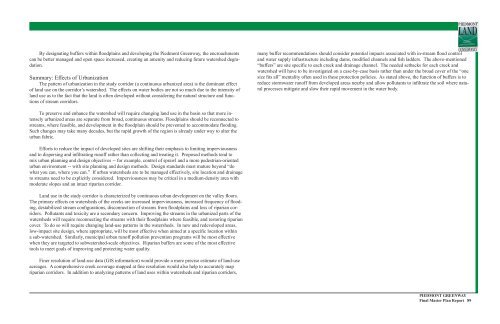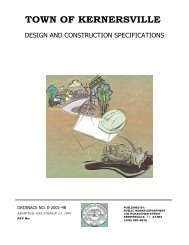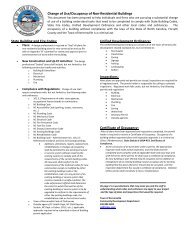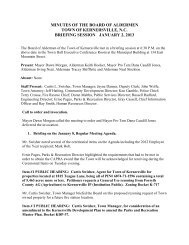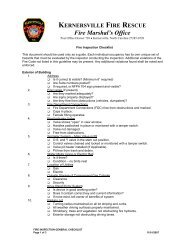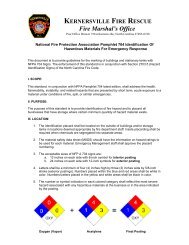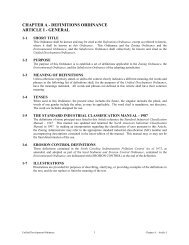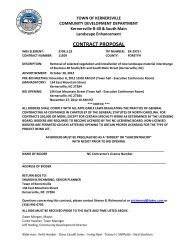Piedmont Greenway Master Plan - Town of Kernersville
Piedmont Greenway Master Plan - Town of Kernersville
Piedmont Greenway Master Plan - Town of Kernersville
- No tags were found...
Create successful ePaper yourself
Turn your PDF publications into a flip-book with our unique Google optimized e-Paper software.
By designating buffers within floodplains and developing the <strong>Piedmont</strong> <strong>Greenway</strong>, the encroachments<br />
can be better managed and open space increased, creating an amenity and reducing future watershed degradation.<br />
Summary: Effects <strong>of</strong> Urbanization<br />
The pattern <strong>of</strong> urbanization in the study corridor (a continuous urbanized area) is the dominant effect<br />
<strong>of</strong> land use on the corridor’s watershed. The effects on water bodies are not so much due to the intensity <strong>of</strong><br />
land use as to the fact that the land is <strong>of</strong>ten developed without considering the natural structure and functions<br />
<strong>of</strong> stream corridors.<br />
many buffer recommendations should consider potential impacts associated with in-stream flood control<br />
and water supply infrastructure including dams, modified channels and fish ladders. The above-mentioned<br />
“buffers” are site specific to each creek and drainage channel. The needed setbacks for each creek and<br />
watershed will have to be investigated on a case-by-case basis rather than under the broad cover <strong>of</strong> the “one<br />
size fits all” mentality <strong>of</strong>ten used in these protection policies. As stated above, the function <strong>of</strong> buffers is to<br />
reduce stormwater run<strong>of</strong>f from developed areas nearby and allow pollutants to infiltrate the soil where natural<br />
processes mitigate and slow their rapid movement in the water body.<br />
To preserve and enhance the watershed will require changing land use in the basin so that more intensely<br />
urbanized areas are separate from broad, continuous streams. Floodplains should be reconnected to<br />
streams, where feasible, and development in the floodplain should be prevented to accommodate flooding.<br />
Such changes may take many decades, but the rapid growth <strong>of</strong> the region is already under way to alter the<br />
urban fabric.<br />
Efforts to reduce the impact <strong>of</strong> developed sites are shifting their emphasis to limiting imperviousness<br />
and to dispersing and infiltrating run<strong>of</strong>f rather than collecting and treating it. Proposed methods tend to<br />
mix urban planning and design objectives -- for example, control <strong>of</strong> sprawl and a more pedestrian-oriented<br />
urban environment -- with site planning and design methods. Design standards must mature beyond “do<br />
what you can, where you can.” If urban watersheds are to be managed effectively, site location and drainage<br />
to streams need to be explicitly considered. Imperviousness may be critical in a medium-density area with<br />
moderate slopes and an intact riparian corridor.<br />
Land use in the study corridor is characterized by continuous urban development on the valley floors.<br />
The primary effects on watersheds <strong>of</strong> the creeks are increased imperviousness, increased frequency <strong>of</strong> flooding,<br />
destabilized stream configurations, disconnection <strong>of</strong> streams from floodplains and loss <strong>of</strong> riparian corridors.<br />
Pollutants and toxicity are a secondary concern. Improving the streams in the urbanized parts <strong>of</strong> the<br />
watersheds will require reconnecting the streams with their floodplains where feasible, and restoring riparian<br />
cover. To do so will require changing land-use patterns in the watersheds. In new and redeveloped areas,<br />
low-impact site design, where appropriate, will be most effective when aimed at a specific location within<br />
a sub-watershed. Similarly, municipal urban run<strong>of</strong>f pollution prevention programs will be most effective<br />
when they are targeted to subwatershed-scale objectives. Riparian buffers are some <strong>of</strong> the most effective<br />
tools to meet goals <strong>of</strong> improving and protecting water quality.<br />
Finer resolution <strong>of</strong> land-use data (GIS information) would provide a more precise estimate <strong>of</strong> land-use<br />
acreages. A comprehensive creek coverage mapped at fine resolution would also help to accurately map<br />
riparian corridors. In addition to analyzing patterns <strong>of</strong> land uses within watersheds and riparian corridors,<br />
PIEDMONT GREENWAY<br />
Final <strong>Master</strong> <strong>Plan</strong> Report 89


